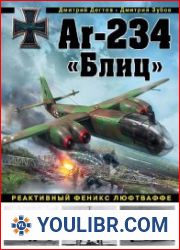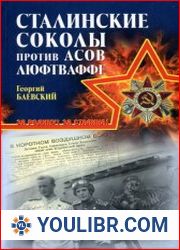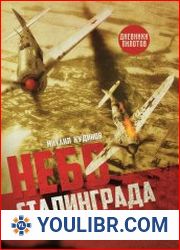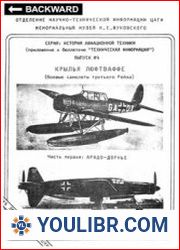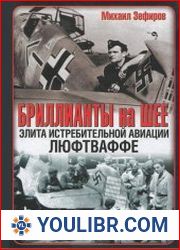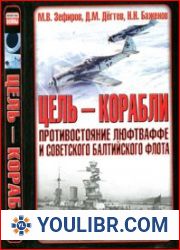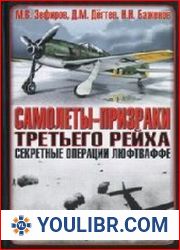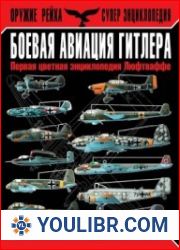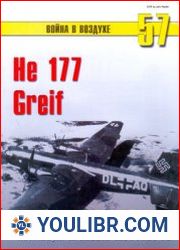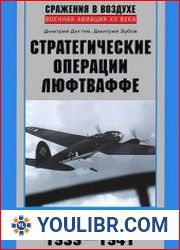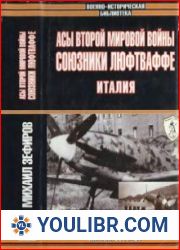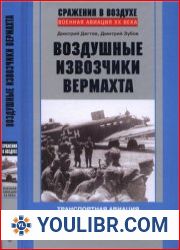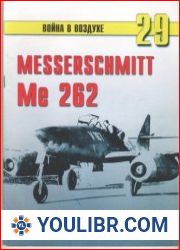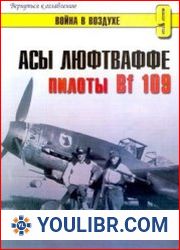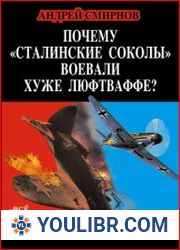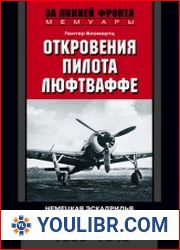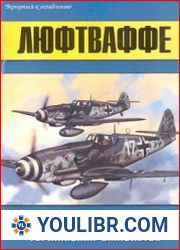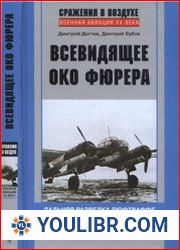
BOOKS - MILITARY HISTORY - "Разрушители" Люфтваффе Bf 110, Me 210, Me 410...

"Разрушители" Люфтваффе Bf 110, Me 210, Me 410
Author: Андрей Харук
Year: 2011
Format: PDF
File size: 126.6 MB
Year: 2011
Format: PDF
File size: 126.6 MB
Zerstorer ("Destroyer") - this is how destroyers were called in the German Navy, and in the Luftwaffe - a special class of aircraft that did not have an analogue in Soviet aviation, being a product of the blitzkrieg concept and intended for combat use over enemy territory, destruction of the enemy air force and ensuring the actions of its own bombers. However, the idea turned out to be stillborn - the very first "Cersterer" Bf 110, designed by V. Messerschmitt as a long-range fighter of escort and conquest of air superiority, was used for its intended purpose for a very short time: already in the summer of 1940 it became clear that the "one hundred and tenth" could not cope with the tasks set, and it was necessary to urgently modify it into a high-speed bomber, reconnaissance and night fighter, and if on the Western Front it was used primarily as an interceptor, becoming the basis of the Reich air defense, then in Russia - as an attack aircraft. The fate of the cars that were supposed to replace him was much less successful - Me 210 became the main failure in Messerschmitt's career, beating everything "records" of accidents, destroying many pilots and, in the end, being disgracefully discontinued, and the radically redesigned Me 410, which finally succeeded "bring to mind," began to enter the combat units too late, when its niche was long occupied by fighter-bomber modifications of the Fw 190, and achieved the main successes as a heavy day air defense fighter, although this "role" was not even considered when developing tactical and technical requirements for the project. As a result, there was a paradoxical situation when the "old man" Bf 110 was in production longer than the aircraft created to replace it, and was used from the first to the last day of the war. This book restores the true story of the Luftwaffe's "Destroyers" from the rise to fall of the Third Reich, from the first high-profile victories to the crushing defeat and unconditional surrender of Hitler's Germany.
.Книга «Разрушители Люфтваффе Bf 110 Me 210 Me 410» предлагает подробный отчет о разработке, развитии и развертывании трех ключевых немецких истребителей во время Второй мировой войны: Bf 110, Me 210 и Me 410. Автор использует комплексный подход, исследуя технологические достижения, стратегические намерения и операционные проблемы, которые окружали эти самолеты, а также подчеркивая их ограничения и окончательную гибель. Повествование строится вокруг концепции эволюции технологий и необходимости личностной парадигмы для понимания процесса развития современных знаний. Книга начинается с того, что знакомит читателя со стратегией блицкрига и ролью самолетов класса Zerstörer («Разрушитель») в немецком Люфтваффе Эти самолеты были предназначены для обеспечения превосходства в воздухе и уничтожения военно-воздушных сил противника, обеспечивая успех немецких бомбардировщиков. Однако, по мере развития войны, Bf 110 оказался недостаточным для своего целевого назначения, что привело к быстрым модификациям и переделкам. Me 210, предназначенный в качестве замены, страдал от многочисленных аварий и технических проблем, в конечном итоге будучи снятым с производства. Me 410, радикально переработанная версия, поступила на вооружение слишком поздно и не смогла достичь намеченных целей. 本「ドイツ空軍駆逐艦Bf 110 Me 210 Me 410」は、第二次世界大戦中の3つの主要なドイツ戦闘機の開発、開発、配備の詳細な説明を提供しています:Bf 110、 Me 210とMe 410。著者は、これらの航空機を取り巻く技術の進歩、戦略的意図、運用上の課題を探求し、その限界と究極の終焉を強調する統合的なアプローチをとります。物語は、技術の進化の概念と現代の知識の発展を理解するための個人的なパラダイムの必要性を中心に構築されています。本書は、ドイツ空軍におけるZerstörer(「駆逐艦」)クラスの航空機の役割とblitzkrieg戦略に読者を紹介することから始まりますこれらの航空機は、ドイツの爆撃機の成功を確保し、航空優位性を提供し、敵空軍を破壊するために設計されました。しかし、戦争が進むにつれて、Bf110は意図した目的には不十分であることが判明し、急速な変更と変更につながった。Me 210は代替機として計画されていたが、数多くのクラッシュや技術的な問題に見舞われ、最終的に生産中止となった。根本的に再設計されたMe 410は、遅すぎるサービスに入り、意図された目標を達成することができませんでした。 يقدم كتاب «Luftwaffe Destroyers Bf 110 Me 210 Me» 410 سردًا مفصلاً لتطوير وتطوير ونشر ثلاثة مقاتلين ألمان رئيسيين خلال الحرب العالمية الثانية: Bf 110 و Me 210 و Me 410. يتبع المؤلف نهجًا متكاملاً، حيث يستكشف التقدم التكنولوجي والنوايا الاستراتيجية والتحديات التشغيلية التي أحاطت بهذه الطائرات، فضلاً عن تسليط الضوء على قيودها وزوالها النهائي. السرد مبني على مفهوم تطور التكنولوجيا والحاجة إلى نموذج شخصي لفهم تطور المعرفة الحديثة. يبدأ الكتاب بتعريف القارئ باستراتيجية الحرب الخاطفة ودور طائرات Zerstörer («المدمرة») في لوفتفافه الألمانية. تم تصميم هذه الطائرات لتوفير التفوق الجوي وتدمير القوات الجوية للعدو، مما يضمن نجاح القاذفات الألمانية. ومع ذلك، مع تقدم الحرب، أثبتت Bf 110 أنها غير كافية للغرض المقصود منها، مما أدى إلى تعديلات وتعديلات سريعة. عانى Me 210، الذي كان يهدف إلى أن يكون بديلاً، من العديد من الحوادث والمشاكل الفنية، وتم إيقافه في النهاية. دخل Me 410، وهو إصدار أعيد تصميمه جذريًا، الخدمة بعد فوات الأوان وفشل في تحقيق أهدافه المقصودة. .Cniga «Distruttori di Luftwaffe Bf 110 Me 210 Me 410» fornisce un rapporto dettagliato sullo sviluppo, lo sviluppo e l'implementazione di tre caccia tedeschi chiave durante la seconda guerra mondiale: Bf 110, Me 210 e Me 410. L'autore utilizza un approccio completo, esplorando i progressi tecnologici, le intenzioni strategiche e i problemi operativi che hanno circondato questi aerei e sottolineando i loro limiti e la morte finale. La narrazione si basa sul concetto di evoluzione della tecnologia e sulla necessità di un paradigma personale per comprendere il processo di sviluppo della conoscenza moderna. Il libro inizia facendo conoscere al lettore la strategia di blitzkrieg e il ruolo degli aerei della classe Zerstörer (il distruttore) a Luftwaffe in Germania Questi aerei sono stati progettati per garantire la supremazia aerea e distruggere l'aeronautica nemica, garantendo il successo dei bombardieri tedeschi. Tuttavia, con l'evoluzione della guerra, il Bf 110 è risultato insufficiente al suo obiettivo, che ha portato a rapidi cambiamenti e modifiche. Me 210, progettato come sostituto, soffriva di numerosi incidenti e problemi tecnici, finendo per essere ritirato dalla produzione. Me 410, una versione radicalmente ridisegnata, è arrivata troppo tardi e non è riuscita a raggiungere gli obiettivi prefissati. הספר ”Luftwaffa Develyers Bf 110 Me 210 Me 410” מציע תיאור מפורט של פיתוח, פיתוח ופריסה של שלושה מטוסי קרב גרמניים מרכזיים במהלך מלחמת העולם השנייה: Bf 110, Me 210 ו-Me 410. המחבר נוקט בגישה משולבת, בוחן את ההתקדמות הטכנולוגית, הכוונות האסטרטגיות והאתגרים המבצעיים שהקיפו את המטוסים הללו, כמו גם מדגיש את המגבלות שלהם ואת המוות האולטימטיבי שלהם. הנרטיב בנוי סביב הרעיון של התפתחות הטכנולוגיה והצורך בפרדיגמה אישית כדי להבין את התפתחות הידע המודרני. הספר מתחיל בכך שהוא מציג את הקורא לאסטרטגיית הבליצקריג ואת תפקידו של מטוס ההשמדה (Zerstörer) בלופטוואפה הגרמני, מטוסים אלה נועדו לספק עליונות אווירית ולהשמיד את חילות האוויר של האויב, ובכך להבטיח את הצלחת המפציצים הגרמניים. עם זאת, עם התקדמות המלחמה, ה-BF 110 לא היה מספיק למטרתו המיועדת, מה שהוביל לשינויים מהירים. ה-Me 210, שנועד כתחליף, סבל מהתרסקויות רבות ובעיות טכניות, ובסופו של דבר הופסקו. ה-Me 410, גרסה שעוצבה מחדש באופן קיצוני, נכנסה לשירות מאוחר מדי ולא הצליחה להשיג את מטרותיה. .Das Buch „Zerstörer der Luftwaffe Bf 110 Me 210 Me 410“ bietet einen detaillierten Bericht über die Entwicklung, Entwicklung und den Einsatz von drei wichtigen deutschen Kampfflugzeugen während des Zweiten Weltkriegs: Bf 110, Me 210 und Me 410. Der Autor verfolgt einen integrierten Ansatz, indem er die technologischen Fortschritte, strategischen Absichten und operativen Herausforderungen, die diese Flugzeuge umgeben, untersucht und ihre Grenzen und den endgültigen Tod hervorhebt. Die Erzählung basiert auf dem Konzept der Technologieentwicklung und der Notwendigkeit eines persönlichen Paradigmas, um den Entwicklungsprozess des modernen Wissens zu verstehen. Das Buch beginnt damit, den ser mit der Blitzkrieg-Strategie und der Rolle der Zerstörer-Klasse-Flugzeuge in der deutschen Luftwaffe vertraut zu machen.Diese Flugzeuge sollten die Luftüberlegenheit sichern und die feindliche Luftwaffe zerstören, was den Erfolg der deutschen Bomber sicherstellte. Im Laufe des Krieges erwies sich die Bf 110 jedoch als unzureichend für ihren Zweck, was zu schnellen Modifikationen und Umbauten führte. Die als Ersatz vorgesehene Me 210 litt unter zahlreichen Unfällen und technischen Problemen und wurde schließlich eingestellt. Die Me 410, eine radikal überarbeitete Version, kam zu spät in Dienst und konnte ihre Ziele nicht erreichen. Książka „Luftwaffe niszczyciele Bf 110 Me 210 Me 410” oferuje szczegółowy opis rozwoju, rozwoju i rozmieszczenia trzech głównych niemieckich myśliwców podczas II wojny światowej: Bf 110, Me 210 i Me 410. Autor przyjmuje zintegrowane podejście, badając postęp technologiczny, strategiczne zamiary i wyzwania operacyjne, które otaczały te samoloty, a także podkreślając ich ograniczenia i ostateczną zagładę. Narracja jest zbudowana wokół koncepcji ewolucji technologii i potrzeby osobistego paradygmatu, aby zrozumieć rozwój nowoczesnej wiedzy. Książka rozpoczyna się od wprowadzenia czytelnika do strategii blitzkrieg i roli samolotów klasy Zerstörer ("niszczyciel') w niemieckim Luftwaffe Samoloty te zostały zaprojektowane tak, aby zapewnić wyższość powietrza i zniszczyć wrogie siły powietrzne, zapewniając sukces niemieckich bombowców. Jednak wraz z postępem wojny Bf 110 okazał się niewystarczający do zamierzonego celu, co doprowadziło do szybkich modyfikacji i zmian. Me 210, przeznaczony jako zamiennik, doznał licznych awarii i problemów technicznych, które ostatecznie zostały przerwane. The Me 410, radykalnie przeprojektowana wersja, weszła do serwisu zbyt późno i nie osiągnęła zamierzonych celów. "Luftwaffe Destroyers Bf 110 Me 210 Me 410" 책은 제 2 차 세계 대전 중 3 개의 주요 독일 전투기의 개발, 개발 및 배치에 대한 자세한 설명을 제공합니다: Bf 110, Me 210 및 Me 410. 저자는 통합 접근 방식을 취하여 항공기를 둘러싼 기술 발전, 전략적 의도 및 운영 문제를 조사하고 한계와 궁극적 인 소멸을 강조합니다. 이야기는 기술의 진화 개념과 현대 지식의 발전을 이해하기위한 개인적인 패러다임의 필요성을 중심으로 구축되었습니다. 이 책은 독자들에게 블리츠 크리 그 전략과 독일 루프트 바페에서 Zerstörer ("Destroyer") 급 항공기의 역할을 소개함으로써 시작됩니다. 그러나 전쟁이 진행됨에 따라 Bf 110은 의도 한 목적에 불충분하여 빠른 수정 및 변경으로 이어졌습니다. 대체품으로 의도 된 Me 210은 수많은 충돌과 기술적 문제를 겪고 결국 중단되었습니다. 근본적으로 재 설계된 버전 인 Me 410은 서비스에 너무 늦게 들어 와서 의도 한 목표를 달성하지 못했습니다. . The book "Разрушители Люфтваффе Bf 110 Me 210 Me 410" offers a detailed account of the development, evolution, and deployment of three key German fighter planes during World War II: the Bf 110, Me 210, and Me 410. The author takes a comprehensive approach, exploring the technological advancements, strategic intentions, and operational challenges that surrounded these aircraft, while also highlighting their limitations and ultimate demise. The narrative is structured around the concept of technology evolution and the need for a personal paradigm to understand the process of developing modern knowledge. The book begins by introducing the reader to the blitzkrieg strategy and the role of the Zerstörer (Destroyer) class of aircraft in the German Luftwaffe. These planes were designed to provide air superiority and destroy enemy air forces, ensuring the success of German bombers. However, as the war progressed, the Bf 110 proved inadequate for its intended purpose, leading to rapid modifications and redesigns. The Me 210, intended as a replacement, suffered from numerous accidents and technical issues, ultimately being discontinued. The Me 410, a radically redesigned version, entered service too late and failed to achieve its intended goals. . Kniga «Destructores Luftwaffe Bf 110 Me 210 Me 410» ofrece un informe detallado sobre el desarrollo, desarrollo y despliegue de tres cazas alemanes clave durante la Segunda Guerra Mundial: Bf 110, Me 210 y Me 410. autor adopta un enfoque integral, investigando los avances tecnológicos, las intenciones estratégicas y los problemas operativos que rodearon a estos aviones, además de resaltar sus limitaciones y la muerte final. La narración se construye en torno al concepto de evolución de la tecnología y la necesidad de un paradigma personal para entender el proceso de desarrollo del conocimiento moderno. libro comienza introduciendo al lector la estrategia de la blitzkrieg y el papel de los aviones de la clase Zerstörer («Destructor») en la Luftwaffe alemana Estos aviones fueron diseñados para asegurar la superioridad aérea y la destrucción de las fuerzas aéreas enemigas, asegurando el éxito de los bombarderos alemanes. n embargo, a medida que la guerra avanzó, el Bf 110 resultó insuficiente para su propósito objetivo, lo que llevó a modificaciones y alteraciones rápidas. Me 210, destinado como sustituto, sufrió numerosos accidentes y problemas técnicos, siendo finalmente retirado de la producción. Me 410, una versión radicalmente rediseñada, entró en servicio demasiado tarde y no logró los objetivos previstos. .Niga «Destruidores de Luftwaffe Bf 110 Me 210 Me 410» oferece um relatório detalhado sobre o desenvolvimento, desenvolvimento e implementação de três caças alemães-chave durante a Segunda Guerra Mundial: Bf 110, Me 210 e Me 410. O autor utiliza uma abordagem complexa, explorando os avanços tecnológicos, as intenções estratégicas e os problemas operacionais que cercaram esses aviões, e enfatizando suas limitações e mortes definitivas. A narrativa se baseia no conceito da evolução da tecnologia e na necessidade de um paradigma pessoal para compreender o processo de desenvolvimento do conhecimento moderno. O livro começa apresentando ao leitor a estratégia de blitzkrieg e o papel dos aviões Zerstörer («demolidor») em Luftwaffe, na Alemanha. No entanto, à medida que a guerra avançava, o Bf 110 não era suficiente para a sua meta, o que levou a modificações e remodelações rápidas. Me 210, projetado como substituto, sofreu muitos acidentes e problemas técnicos, sendo eventualmente retirado da produção. O Me 410, uma versão radicalmente reformulada, chegou tarde demais e não conseguiu atingir os objetivos. .Kniga « s destructeurs de la Luftwaffe Bf 110 Me 210 Me 410 » propose un rapport détaillé sur le développement, le développement et le déploiement de trois avions de chasse allemands clés pendant la Seconde Guerre mondiale : Bf 110, Me 210 et Me 410. L'auteur adopte une approche intégrée en examinant les progrès technologiques, les intentions stratégiques et les problèmes opérationnels qui entouraient ces avions, et en soulignant leurs limites et leur mort finale. La narration repose sur le concept de l'évolution des technologies et sur la nécessité d'un paradigme personnel pour comprendre le processus de développement des connaissances modernes. livre commence par présenter au lecteur la stratégie de blitzkrieg et le rôle des avions de classe Zerstörer (« Destructeur ») dans la Luftwaffe allemande. Ces avions étaient conçus pour assurer la supériorité aérienne et la destruction des forces aériennes ennemies, assurant le succès des bombardiers allemands. Cependant, au fur et à mesure de la guerre, le Bf 110 s'est avéré insuffisant pour son objectif, ce qui a conduit à des modifications et des changements rapides. Me 210, destiné à remplacer, a subi de nombreux accidents et problèmes techniques, finissant par être retiré de la production. Me 410, une version radicalement remaniée, est entrée en service trop tard et n'a pas réussi à atteindre les objectifs fixés. pdf dosyasını indir להוריד קובץ PDF download pdf file PDF-Datei herunterladen PDFファイルをダウンロード تنزيل ملف pdf pobierz plik pdf скачать файл PDF Scarica il file pdf descargar archivo pdf télécharger le fichier pdf descarregar ficheiro pdf 下载 pdf 文件 download pdf file pdf 파일 다운로드
Zerstorer («Distruttore») - Così la marina tedesca chiamava i cacciatorpedinieri, mentre Luftwaffe era una classe speciale di aeroplani che non aveva l'equivalente dell'aviazione sovietica, che generava il concetto di blitzkrieg e che era destinata ad essere usata per combattere contro il territorio nemico, distruggere l'aeronautica e garantire l'azione dei propri bombardieri. Ma l'idea si è rivelata morta - il primo Cerchterer Bf 110, progettato da V.Messerschmitt come un caccia di scorta a lungo raggio e conquista di eccellenza aerea, è stato usato a scopo diretto per pochissimo tempo: Già nell'estate del 1940 era stato chiaro che il «centodiesimo» non funzionava, ed è stato necessario modificarlo con urgenza in un bombardiere ad alta velocità, un esploratore e un caccia notturno, e se sul fronte occidentale è stato usato soprattutto come intercettore, diventando la base della difesa aerea del Reich, in Russia è come un aereo da attacco. Molto meno fortunato è stato il destino delle macchine che dovevano sostituirlo - M' 210 è stato il principale fallimento della carriera di Messerchmitt, battendo tutto. «record» di emergenza, uccidendo molti piloti e, alla fine, essendo stato disonorevolmente rimosso dalla produzione, e il M' 410 radicalmente riciclato, che finalmente è riuscito «Far impazzire», ha cominciato ad arrivare troppo tardi nelle parti di combattimento, quando la sua nicchia era da tempo impegnata nelle modifiche a caccia e bombardamenti Fw 190, e i principali successi sono stati ottenuti come caccia antiaereo pesante diurno, anche se questa ampiezza non è stata nemmeno considerata nel definire i requisiti tattici e tecnici del progetto. Alla fine si è verificata una situazione paradossale in cui il «vecchio» Bf 110 è stato prodotto più a lungo degli aerei creati per sostituirlo e utilizzato dal primo all'ultimo giorno di guerra. Questo libro ricostruisce la storia autentica dei Distruttori di Luftwaffe, dal decollo alla caduta del Terzo Reich, dalle prime grandi vittorie alla devastante sconfitta e alla resa incondizionata della Germania di Hitler.
Zerstorer (« Destructeur ») - c'est ainsi que la marine allemande appelait les destroyers, et à Luftwaffe, une classe spéciale d'avions qui n'avait pas d'équivalent dans l'aviation soviétique, générant le concept de blitzkrieg et destiné à être utilisé pour combattre sur le territoire ennemi, détruire l'armée de l'air de l'ennemi et fournir ses propres bombardiers. Mais l'idée s'est avérée morte-née - le premier Cersterer Bf 110, conçu par V.Messerschmitt comme un chasseur de longue distance d'escorte et de supériorité aérienne, n'a pas été utilisé directement pendant longtemps : dès l'été 1940, il est devenu clair que les objectifs du « cent dixième » échouaient et qu'il était urgent de le modifier en bombardier rapide, en éclaireur et en chasseur de nuit, et si sur le front occidental, il était principalement utilisé comme intercepteur, devenant la base de la défense aérienne du Reich, en Russie, comme un avion de frappe. Le sort des voitures qui devaient le remplacer a été beaucoup moins réussi - Me 210 a été le principal échec de la carrière de Messerschmitt, battant tout les « records » de l'accident, ayant tué de nombreux pilotes et, finalement, ayant été honteusement retiré de la production, et le Me 410 radicalement recyclé, qui a finalement réussi « à l'esprit », a commencé à entrer dans les unités de combat trop tard, lorsque sa niche a été longtemps occupée par des modifications de combat et de bombardement Fw 190, et a obtenu les principaux succès en tant que chasseur antiaérien de jour lourd, bien que ce « ampoule » n'ait même pas été considéré dans l'élaboration des exigences tactiques et techniques du projet. En conséquence, il y a eu une situation paradoxale où le « vieil homme » Bf 110 était en production plus longtemps que les avions créés pour le remplacer et a été utilisé du premier au dernier jour de la guerre. Ce livre restaure l'histoire authentique des « Destructeurs » de la Luftwaffe, du décollage à la chute du Troisième Reich, des premières victoires à la défaite écrasante et à la capitulation inconditionnelle de l'Allemagne d'Hitler.
Zerstorer ("Destroyer") - this is how destroyers were called in the German Navy, and in the Luftwaffe - a special class of aircraft that did not have an analogue in Soviet aviation, being a product of the blitzkrieg concept and intended for combat use over enemy territory, destruction of the enemy air force and ensuring the actions of its own bombers. However, the idea turned out to be stillborn - the very first "Cersterer" Bf 110, designed by V. Messerschmitt as a long-range fighter of escort and conquest of air superiority, was used for its intended purpose for a very short time: already in the summer of 1940 it became clear that the "one hundred and tenth" could not cope with the tasks set, and it was necessary to urgently modify it into a high-speed bomber, reconnaissance and night fighter, and if on the Western Front it was used primarily as an interceptor, becoming the basis of the Reich air defense, then in Russia - as an attack aircraft. The fate of the cars that were supposed to replace him was much less successful - Me 210 became the main failure in Messerschmitt's career, beating everything "records" of accidents, destroying many pilots and, in the end, being disgracefully discontinued, and the radically redesigned Me 410, which finally succeeded "bring to mind," began to enter the combat units too late, when its niche was long occupied by fighter-bomber modifications of the Fw 190, and achieved the main successes as a heavy day air defense fighter, although this "role" was not even considered when developing tactical and technical requirements for the project. As a result, there was a paradoxical situation when the "old man" Bf 110 was in production longer than the aircraft created to replace it, and was used from the first to the last day of the war. This book restores the true story of the Luftwaffe's "Destroyers" from the rise to fall of the Third Reich, from the first high-profile victories to the crushing defeat and unconditional surrender of Hitler's Germany.
Zerstore é uma classe especial de aviões que não tinha semelhança na aviação soviética, tendo como origem o conceito de blitzkrig e tendo como objetivo o uso de combate sobre o território inimigo, a destruição da força aérea inimiga e a ação de seus próprios bombardeiros. No entanto, a ideia foi de nascer morto - o primeiro «Cerchterer» Bf 110, projetado por V.Messerschmitt como um exterminador de longa distância de escolta e supremacia aérea, foi usado por um propósito direto pouco tempo: No verão de 1940, ficou claro que as tarefas do «cento e dez» estavam falhadas, e foi necessário modificá-lo para um bombardeiro de alta velocidade, um espião e um caça noturno, sendo usado principalmente como interceptador na frente ocidental, tornando-se a base da defesa antiaérea do Reich, na Rússia como um avião de ataque. Muito menos bem o destino das máquinas que deveriam substituí-lo - Me 210 foi o maior fracasso da carreira de Messershmitt, batendo tudo. «recordes» da emergência, destruindo muitos pilotos e, finalmente, sendo desonrosamente retirado da produção, e um Me 410 transformado radicalmente, que finalmente conseguiu «levar à mente», começou a chegar tarde demais às partes de combate, quando o seu nicho estava ocupado há muito tempo pelas modificações de exterminação e bombardeio do Fw 190, e os maiores avanços foram feitos como um pesado caça antiaéreo diurno, embora este «amplois» nem sequer tenha sido considerado na elaboração dos requisitos tático-técnicos para o projeto. Finalmente, houve uma situação paradoxal em que o «velho» Bf 110 estava fabricando mais do que os aviões criados para substituí-lo, e foi usado do primeiro ao último dia da guerra. Este livro recupera a história autêntica de «Os Destruidores» de Luftwaffe, desde a decolagem até a queda do Terceiro Reich, desde as primeiras grandes vitórias até a derradeira derrota e a rendição incondicional da Alemanha de Hitler.
Zerstorer („Zerstörer“) - wie Zerstörer in der deutschen Marine genannt wurden, und in der Luftwaffe - eine besondere Klasse von Flugzeugen, die in der sowjetischen Luftfahrt kein Analogon hatten, ein Produkt des Blitzkriegs-Konzepts waren und für den Kampfeinsatz über feindlichem Territorium, die Zerstörung der feindlichen Luftwaffe und die Sicherung der Aktionen ihrer eigenen Bomber bestimmt waren. Die Idee erwies sich jedoch als Totgeburt - der erste Zersterer Bf 110, der von V. Messerschmitt als Langstreckenjäger zur Begleitung und Eroberung der Luftüberlegenheit entworfen wurde, wurde für kurze Zeit für seinen beabsichtigten Zweck verwendet: Bereits im Sommer von 1940 wurde klar, dass die Hundertzehnte den gestellten Aufgaben nicht gewachsen war, und es musste dringend zu einem Hochgeschwindigkeitsbomber, Aufklärer und Nachtjäger umgebaut werden, und wenn sie an der Westfront in erster Linie als Abfangjäger eingesetzt wurde und zur Grundlage der Luftverteidigung des Reiches wurde, dann in Russland - als Kampfflugzeug. Viel weniger erfolgreich war das Schicksal der Maschinen, die ihn ersetzen sollten - Me 210 wurde zum Hauptversagen in der Karriere von Messerschmitt und schlug alles. „Rekorde“ Unfälle, viele Piloten zu ruinieren und, am Ende, mit Schande aus der Produktion genommen, und radikal überarbeitet Me 410, die schließlich gelungen „zur Vernunft zu bringen“, begann zu spät in die Kampfeinheiten einzudringen, als seine Nische lange Zeit mit Jagdbomber-Modifikationen der Fw 190 besetzt war und die wichtigsten Erfolge als schwerer Tagesjäger der Luftverteidigung erzielte, obwohl diese „Rolle“ bei der Entwicklung der taktischen und technischen Anforderungen an das Projekt nicht einmal berücksichtigt wurde. Infolgedessen gab es eine paradoxe Situation, in der der „alte Mann“ Bf 110 länger in Produktion war als die Flugzeuge, die geschaffen wurden, um ihn zu ersetzen, und vom ersten bis zum letzten Tag des Krieges verwendet wurde. Dieses Buch rekonstruiert die wahre Geschichte der „Zerstörer“ der Luftwaffe vom Start bis zum Fall des Dritten Reiches, von den ersten hochkarätigen Siegen bis zur vernichtenden Niederlage und bedingungslosen Kapitulation Hitlerdeutschlands.
Zerstorer (Разрушитель) - так в германском военно-морском флоте называли эсминцы, а в Люфтваффе - особый класс самолетов, который не имел аналога в советской авиации, будучи порождением концепции блицкрига и предназначаясь для боевого применения над вражеской территорией, разрушения ВВС противника и обеспечения действий собственных бомбардировщиков. Однако идея оказалась мертворожденной - первый же Церштерер Bf 110, спроектированный В.Мессершмиттом как дальний истребитель сопровождения и завоевания превосходства в воздухе, использовался по прямому назначению совсем недолго уже летом 1940 года стало ясно, что с поставленными задачами сто десятый не справляется, и пришлось срочно модифицировать его в скоростной бомбардировщик, разведчик и ночной истребитель, причем если на Западном фронте он использовался прежде всего как перехватчик, став основой ПВО Рейха, то в России - как ударный самолет. Куда менее удачно сложилась судьба машин, которые должны были прийти ему на смену, - Ме 210 стал главным провалом в карьере Мессершмитта, побив все рекорды аварийности, погубив множество летчиков и, в конце концов, будучи с позором снят с производства, а кардинально переработанный Ме 410, который, наконец, удалось довести до ума, начал поступать в боевые части слишком поздно, когда его ниша была давно занята истребительно-бомбардировочными модификациями Fw 190, и главных успехов добился в качестве тяжелого дневного истребителя ПВО, хотя это амплуа даже не рассматривалось при выработке тактико-технических требований к проекту. В итоге сложилась парадоксальная ситуация, когда старичок Bf 110 находился в производстве дольше самолетов, созданных для его замены, и применялся с первого и до последнего дня войны. Эта книга восстанавливает подлинную историю Разрушителей Люфтваффе от взлета до падения Третьего Рейха, от первых громких побед до сокрушительного разгрома и безоговорочной капитуляции гитлеровской Германии.
Zerstorer («El Destructor») - como se llamaba en la armada alemana a los destructores, y en la Luftwaffe a una clase especial de aviones que no tenía contrapartida en la aviación soviética, dando lugar al concepto de blitzkrieg y destinado a ser utilizado militarmente sobre el territorio enemigo, destruir la fuerza aérea enemiga y asegurar la acción de sus propios bombarderos. Sin embargo, la idea resultó ser de nacimiento muerto - el primer «Cerstterer» Bf 110, diseñado por V.Messerschmitt como un caza de larga distancia de escolta y conquista de la supremacía aérea, fue utilizado con un propósito directo durante bastante poco tiempo: ya en el verano de 1940 se hizo evidente que el «ciento diez» no podía hacer frente a las tareas asignadas, y tuvo que modificarlo urgentemente en un bombardero de alta velocidad, un explorador y un caza nocturno, y si en el Frente Occidental se utilizaba sobre todo como interceptor, convirtiéndose en la base de la defensa aérea del Reich, en Rusia era como un avión de ataque. Mucho menos afortunado fue el destino de los coches que iban a sucederle, el Me 210 fue el principal fracaso en la carrera de Messerschmitt al batirlo todo "récords' de accidentes, arruinando a muchos aviadores y, al final, siendo sacado de producción con vergüenza, y el drásticamente reciclado Me 410, que finalmente consiguió «traiga a la mente», comenzó a entrar en las unidades de combate demasiado tarde, cuando su nicho estuvo ocupado durante mucho tiempo por las modificaciones de caza y bombardeo del Fw 190, y obtuvo los principales éxitos como caza pesado de día de defensa aérea, aunque este «amplua» ni siquiera fue considerado al elaborar los requisitos tácticos y técnicos para el proyecto. Al final se produjo una situación paradójica cuando el «anciano» Bf 110 estuvo en producción durante más tiempo de los aviones creados para reemplazarlo y se aplicó desde el primer y hasta el último día de la guerra. Este libro recupera la auténtica historia de «Los Destructores» de la Luftwaffe desde el despegue hasta la caída del Tercer Reich, desde las primeras victorias de alto perfil hasta la aplastante derrota y la rendición incondicional de la Alemania de Hitler.
Zerstorer («Distruttore») - Così la marina tedesca chiamava i cacciatorpedinieri, mentre Luftwaffe era una classe speciale di aeroplani che non aveva l'equivalente dell'aviazione sovietica, che generava il concetto di blitzkrieg e che era destinata ad essere usata per combattere contro il territorio nemico, distruggere l'aeronautica e garantire l'azione dei propri bombardieri. Ma l'idea si è rivelata morta - il primo Cerchterer Bf 110, progettato da V.Messerschmitt come un caccia di scorta a lungo raggio e conquista di eccellenza aerea, è stato usato a scopo diretto per pochissimo tempo: Già nell'estate del 1940 era stato chiaro che il «centodiesimo» non funzionava, ed è stato necessario modificarlo con urgenza in un bombardiere ad alta velocità, un esploratore e un caccia notturno, e se sul fronte occidentale è stato usato soprattutto come intercettore, diventando la base della difesa aerea del Reich, in Russia è come un aereo da attacco. Molto meno fortunato è stato il destino delle macchine che dovevano sostituirlo - M' 210 è stato il principale fallimento della carriera di Messerchmitt, battendo tutto. «record» di emergenza, uccidendo molti piloti e, alla fine, essendo stato disonorevolmente rimosso dalla produzione, e il M' 410 radicalmente riciclato, che finalmente è riuscito «Far impazzire», ha cominciato ad arrivare troppo tardi nelle parti di combattimento, quando la sua nicchia era da tempo impegnata nelle modifiche a caccia e bombardamenti Fw 190, e i principali successi sono stati ottenuti come caccia antiaereo pesante diurno, anche se questa ampiezza non è stata nemmeno considerata nel definire i requisiti tattici e tecnici del progetto. Alla fine si è verificata una situazione paradossale in cui il «vecchio» Bf 110 è stato prodotto più a lungo degli aerei creati per sostituirlo e utilizzato dal primo all'ultimo giorno di guerra. Questo libro ricostruisce la storia autentica dei Distruttori di Luftwaffe, dal decollo alla caduta del Terzo Reich, dalle prime grandi vittorie alla devastante sconfitta e alla resa incondizionata della Germania di Hitler.
Zerstorer (« Destructeur ») - c'est ainsi que la marine allemande appelait les destroyers, et à Luftwaffe, une classe spéciale d'avions qui n'avait pas d'équivalent dans l'aviation soviétique, générant le concept de blitzkrieg et destiné à être utilisé pour combattre sur le territoire ennemi, détruire l'armée de l'air de l'ennemi et fournir ses propres bombardiers. Mais l'idée s'est avérée morte-née - le premier Cersterer Bf 110, conçu par V.Messerschmitt comme un chasseur de longue distance d'escorte et de supériorité aérienne, n'a pas été utilisé directement pendant longtemps : dès l'été 1940, il est devenu clair que les objectifs du « cent dixième » échouaient et qu'il était urgent de le modifier en bombardier rapide, en éclaireur et en chasseur de nuit, et si sur le front occidental, il était principalement utilisé comme intercepteur, devenant la base de la défense aérienne du Reich, en Russie, comme un avion de frappe. Le sort des voitures qui devaient le remplacer a été beaucoup moins réussi - Me 210 a été le principal échec de la carrière de Messerschmitt, battant tout les « records » de l'accident, ayant tué de nombreux pilotes et, finalement, ayant été honteusement retiré de la production, et le Me 410 radicalement recyclé, qui a finalement réussi « à l'esprit », a commencé à entrer dans les unités de combat trop tard, lorsque sa niche a été longtemps occupée par des modifications de combat et de bombardement Fw 190, et a obtenu les principaux succès en tant que chasseur antiaérien de jour lourd, bien que ce « ampoule » n'ait même pas été considéré dans l'élaboration des exigences tactiques et techniques du projet. En conséquence, il y a eu une situation paradoxale où le « vieil homme » Bf 110 était en production plus longtemps que les avions créés pour le remplacer et a été utilisé du premier au dernier jour de la guerre. Ce livre restaure l'histoire authentique des « Destructeurs » de la Luftwaffe, du décollage à la chute du Troisième Reich, des premières victoires à la défaite écrasante et à la capitulation inconditionnelle de l'Allemagne d'Hitler.
Zerstorer ("Destroyer") - this is how destroyers were called in the German Navy, and in the Luftwaffe - a special class of aircraft that did not have an analogue in Soviet aviation, being a product of the blitzkrieg concept and intended for combat use over enemy territory, destruction of the enemy air force and ensuring the actions of its own bombers. However, the idea turned out to be stillborn - the very first "Cersterer" Bf 110, designed by V. Messerschmitt as a long-range fighter of escort and conquest of air superiority, was used for its intended purpose for a very short time: already in the summer of 1940 it became clear that the "one hundred and tenth" could not cope with the tasks set, and it was necessary to urgently modify it into a high-speed bomber, reconnaissance and night fighter, and if on the Western Front it was used primarily as an interceptor, becoming the basis of the Reich air defense, then in Russia - as an attack aircraft. The fate of the cars that were supposed to replace him was much less successful - Me 210 became the main failure in Messerschmitt's career, beating everything "records" of accidents, destroying many pilots and, in the end, being disgracefully discontinued, and the radically redesigned Me 410, which finally succeeded "bring to mind," began to enter the combat units too late, when its niche was long occupied by fighter-bomber modifications of the Fw 190, and achieved the main successes as a heavy day air defense fighter, although this "role" was not even considered when developing tactical and technical requirements for the project. As a result, there was a paradoxical situation when the "old man" Bf 110 was in production longer than the aircraft created to replace it, and was used from the first to the last day of the war. This book restores the true story of the Luftwaffe's "Destroyers" from the rise to fall of the Third Reich, from the first high-profile victories to the crushing defeat and unconditional surrender of Hitler's Germany.
Zerstore é uma classe especial de aviões que não tinha semelhança na aviação soviética, tendo como origem o conceito de blitzkrig e tendo como objetivo o uso de combate sobre o território inimigo, a destruição da força aérea inimiga e a ação de seus próprios bombardeiros. No entanto, a ideia foi de nascer morto - o primeiro «Cerchterer» Bf 110, projetado por V.Messerschmitt como um exterminador de longa distância de escolta e supremacia aérea, foi usado por um propósito direto pouco tempo: No verão de 1940, ficou claro que as tarefas do «cento e dez» estavam falhadas, e foi necessário modificá-lo para um bombardeiro de alta velocidade, um espião e um caça noturno, sendo usado principalmente como interceptador na frente ocidental, tornando-se a base da defesa antiaérea do Reich, na Rússia como um avião de ataque. Muito menos bem o destino das máquinas que deveriam substituí-lo - Me 210 foi o maior fracasso da carreira de Messershmitt, batendo tudo. «recordes» da emergência, destruindo muitos pilotos e, finalmente, sendo desonrosamente retirado da produção, e um Me 410 transformado radicalmente, que finalmente conseguiu «levar à mente», começou a chegar tarde demais às partes de combate, quando o seu nicho estava ocupado há muito tempo pelas modificações de exterminação e bombardeio do Fw 190, e os maiores avanços foram feitos como um pesado caça antiaéreo diurno, embora este «amplois» nem sequer tenha sido considerado na elaboração dos requisitos tático-técnicos para o projeto. Finalmente, houve uma situação paradoxal em que o «velho» Bf 110 estava fabricando mais do que os aviões criados para substituí-lo, e foi usado do primeiro ao último dia da guerra. Este livro recupera a história autêntica de «Os Destruidores» de Luftwaffe, desde a decolagem até a queda do Terceiro Reich, desde as primeiras grandes vitórias até a derradeira derrota e a rendição incondicional da Alemanha de Hitler.
Zerstorer („Zerstörer“) - wie Zerstörer in der deutschen Marine genannt wurden, und in der Luftwaffe - eine besondere Klasse von Flugzeugen, die in der sowjetischen Luftfahrt kein Analogon hatten, ein Produkt des Blitzkriegs-Konzepts waren und für den Kampfeinsatz über feindlichem Territorium, die Zerstörung der feindlichen Luftwaffe und die Sicherung der Aktionen ihrer eigenen Bomber bestimmt waren. Die Idee erwies sich jedoch als Totgeburt - der erste Zersterer Bf 110, der von V. Messerschmitt als Langstreckenjäger zur Begleitung und Eroberung der Luftüberlegenheit entworfen wurde, wurde für kurze Zeit für seinen beabsichtigten Zweck verwendet: Bereits im Sommer von 1940 wurde klar, dass die Hundertzehnte den gestellten Aufgaben nicht gewachsen war, und es musste dringend zu einem Hochgeschwindigkeitsbomber, Aufklärer und Nachtjäger umgebaut werden, und wenn sie an der Westfront in erster Linie als Abfangjäger eingesetzt wurde und zur Grundlage der Luftverteidigung des Reiches wurde, dann in Russland - als Kampfflugzeug. Viel weniger erfolgreich war das Schicksal der Maschinen, die ihn ersetzen sollten - Me 210 wurde zum Hauptversagen in der Karriere von Messerschmitt und schlug alles. „Rekorde“ Unfälle, viele Piloten zu ruinieren und, am Ende, mit Schande aus der Produktion genommen, und radikal überarbeitet Me 410, die schließlich gelungen „zur Vernunft zu bringen“, begann zu spät in die Kampfeinheiten einzudringen, als seine Nische lange Zeit mit Jagdbomber-Modifikationen der Fw 190 besetzt war und die wichtigsten Erfolge als schwerer Tagesjäger der Luftverteidigung erzielte, obwohl diese „Rolle“ bei der Entwicklung der taktischen und technischen Anforderungen an das Projekt nicht einmal berücksichtigt wurde. Infolgedessen gab es eine paradoxe Situation, in der der „alte Mann“ Bf 110 länger in Produktion war als die Flugzeuge, die geschaffen wurden, um ihn zu ersetzen, und vom ersten bis zum letzten Tag des Krieges verwendet wurde. Dieses Buch rekonstruiert die wahre Geschichte der „Zerstörer“ der Luftwaffe vom Start bis zum Fall des Dritten Reiches, von den ersten hochkarätigen Siegen bis zur vernichtenden Niederlage und bedingungslosen Kapitulation Hitlerdeutschlands.
Zerstorer (Разрушитель) - так в германском военно-морском флоте называли эсминцы, а в Люфтваффе - особый класс самолетов, который не имел аналога в советской авиации, будучи порождением концепции блицкрига и предназначаясь для боевого применения над вражеской территорией, разрушения ВВС противника и обеспечения действий собственных бомбардировщиков. Однако идея оказалась мертворожденной - первый же Церштерер Bf 110, спроектированный В.Мессершмиттом как дальний истребитель сопровождения и завоевания превосходства в воздухе, использовался по прямому назначению совсем недолго уже летом 1940 года стало ясно, что с поставленными задачами сто десятый не справляется, и пришлось срочно модифицировать его в скоростной бомбардировщик, разведчик и ночной истребитель, причем если на Западном фронте он использовался прежде всего как перехватчик, став основой ПВО Рейха, то в России - как ударный самолет. Куда менее удачно сложилась судьба машин, которые должны были прийти ему на смену, - Ме 210 стал главным провалом в карьере Мессершмитта, побив все рекорды аварийности, погубив множество летчиков и, в конце концов, будучи с позором снят с производства, а кардинально переработанный Ме 410, который, наконец, удалось довести до ума, начал поступать в боевые части слишком поздно, когда его ниша была давно занята истребительно-бомбардировочными модификациями Fw 190, и главных успехов добился в качестве тяжелого дневного истребителя ПВО, хотя это амплуа даже не рассматривалось при выработке тактико-технических требований к проекту. В итоге сложилась парадоксальная ситуация, когда старичок Bf 110 находился в производстве дольше самолетов, созданных для его замены, и применялся с первого и до последнего дня войны. Эта книга восстанавливает подлинную историю Разрушителей Люфтваффе от взлета до падения Третьего Рейха, от первых громких побед до сокрушительного разгрома и безоговорочной капитуляции гитлеровской Германии.
Zerstorer («El Destructor») - como se llamaba en la armada alemana a los destructores, y en la Luftwaffe a una clase especial de aviones que no tenía contrapartida en la aviación soviética, dando lugar al concepto de blitzkrieg y destinado a ser utilizado militarmente sobre el territorio enemigo, destruir la fuerza aérea enemiga y asegurar la acción de sus propios bombarderos. Sin embargo, la idea resultó ser de nacimiento muerto - el primer «Cerstterer» Bf 110, diseñado por V.Messerschmitt como un caza de larga distancia de escolta y conquista de la supremacía aérea, fue utilizado con un propósito directo durante bastante poco tiempo: ya en el verano de 1940 se hizo evidente que el «ciento diez» no podía hacer frente a las tareas asignadas, y tuvo que modificarlo urgentemente en un bombardero de alta velocidad, un explorador y un caza nocturno, y si en el Frente Occidental se utilizaba sobre todo como interceptor, convirtiéndose en la base de la defensa aérea del Reich, en Rusia era como un avión de ataque. Mucho menos afortunado fue el destino de los coches que iban a sucederle, el Me 210 fue el principal fracaso en la carrera de Messerschmitt al batirlo todo "récords' de accidentes, arruinando a muchos aviadores y, al final, siendo sacado de producción con vergüenza, y el drásticamente reciclado Me 410, que finalmente consiguió «traiga a la mente», comenzó a entrar en las unidades de combate demasiado tarde, cuando su nicho estuvo ocupado durante mucho tiempo por las modificaciones de caza y bombardeo del Fw 190, y obtuvo los principales éxitos como caza pesado de día de defensa aérea, aunque este «amplua» ni siquiera fue considerado al elaborar los requisitos tácticos y técnicos para el proyecto. Al final se produjo una situación paradójica cuando el «anciano» Bf 110 estuvo en producción durante más tiempo de los aviones creados para reemplazarlo y se aplicó desde el primer y hasta el último día de la guerra. Este libro recupera la auténtica historia de «Los Destructores» de la Luftwaffe desde el despegue hasta la caída del Tercer Reich, desde las primeras victorias de alto perfil hasta la aplastante derrota y la rendición incondicional de la Alemania de Hitler.











